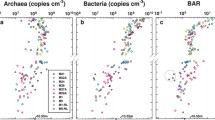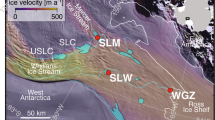Summary
Microbial distribution, substrate uptake, productivity and biomass were investigated in the water column of the Drake Pasage, Antarctica. Organic substrate uptake and productivity were determined by the utilization of [14C] and [3H] glucose and by the incorporation of [3H] adenine and [3H] thymidine into RNA and DNA. Microbial biomass was estimated by ATP concentrations and bacterial abundance by epifluorescence direct counts. Estimates of glucose uptake and productivity indicate that microbes were most active in surface waters and least active below 100 m. Although glucose uptake was generally less than 10 ng/l·h, microbes maintained a low available glucose pool. Glucose concentrations varied from undetectable to 7.5 μg/l with a turnover time of 5–20 days in the euphotic zone and greater than 365 days in Circumpolar Deep Waters. Microbes respired 12 to 32% of the assimilated [14C] glucose. Microbes responsible for the uptake of dissolved organic cabon in the euphotic zone were in the <3 μm size class, presumably bacteria whereas in the aphotic zone the uptake of organics, albeit low, was due to microbes >3 μm, most likely on particles. Microbial ATP-biomass decreased rapidly with increasing water depth and most (∼60–70%) of the ATP-biomass was due to microbes >3 μm. Although bacterial numbers were high (>108 cells/l) at several stations, there were generally between 107 and 108 cells/l with increasing water depth. Bacterial biomass was estimated at <3% of the microbial biomass (7.3 gC/m2) in the euphotic zone. Conservative estimates of secondary productivity by microbes were between 0.5 and 3.0 mg C/m2·d (0.2–54 ng C/l·d).
Similar content being viewed by others
References
Azam F, Hodson RE (1977a) Size distribution and activity of marine microheterophs. Limnol Oceanogr 22:492–501
Azam F, Hodson RE (1977b) Dissolved ATP in the sea and its utilization by marine bacteria. Nature 267:696–698
Azam F, Hodson RE (1981) Multiphasic kinetics for D-glucose uptake by assemblages of natural marine bacteria. Mar Ecol Prog Ser 6:213–222
Azam F, Ammerman JW, Cooper N (1981) Bacterioplankton distributional patterns and metabolic activities in the Scotia Sea. Antarct J U S 16:164–165
Azam F, Beers JR, Campbell, Carlucci AF, Holm-Hansen O, Reid FMH, Karl DM (1979) Occurrence and metabolic activity of organism under the Roos Ice Shelf, Antarctic, at Station J9. Science 203:451–453
Bulleid NC (1978) An improved method for the extraction of adenosine triphosphate from marine sediments and seawater. Limnol Oceanogr 23:174–178
Bunt J (1971) Microbial productivity in Polar regions. Symp Soc Gen Microbiol 21:333–354
Burney CM, Johnson KM, Lavoie DM, Sieburth JMcN (1979) Dissolved carbohydrates and microbial ATP in the North Atlantic Ocean: concentrations and interactions. Deep-Sea Res 26A: 1267–1290
Christian RR, Hanson RB, Newell SY (1982) A comparison of methods to measure bacterial growth rates in mixed cultures. Appl Environ Microbiol 43:1168–1165
Delattre JM, Delesmont R, Clabaux M, Oger C, Leclere H (1979) Bacterial biomass, production and heterotrophic activity of the coastal seawaters at Gravelines (France). Oceanol Acta 27:217–324
Derenbach JB, Williams PJLeB (1974) Autotrophic and bacterial production. Fractionation of plankton populations by differential filtration of samples from the English Channel. Mar Biol 25:263–269
Ducklow HW, Kirchman DL, Rowe GT (1982) Production and vertical flux of attached bacteria in the Hudson Rive Plume of the New York Bight as studied by floating sediment traps. Appl Environ Microbiol 45:769–776
El-Sayed SZ, Taguchi S (1981) Primary production and standing crop of phytoplankton along the ice edge in teh Weddell Sea. Deep-Sea Res 28:1017–1032
Fellows DA, Karl DM, Knauer GA (1981) Large particle fluxes and the vertical transport of living carbon in the upper 1500 meters of the northeast Pacific Ocean. Deep-Sea Res 28A:921–936
Ferguson RL, Rublee P (1976) Contribution of bacteria to standing crop of coastal plankton. Limnol Oceanogr 21:141–144
Fuhrman JA, Azam F (1980) Bacterioplankton secondary production estimates for coastal waters of British Columbia, Antarctica and California. Appl Environ Microbiol 39:1085–1095
Fuhrman JA, Azam F (1982) Thymidine incorporation as a measure of heterotrophic bacterioplankton production in marine surface waters: evaluation and field results. Mar Biol 66:109–120
Fuhrman JA, Ammerman JW, Azam F (1980) Bacterioplankton in the coastal eutrophic zone: distribution, activity and possible relationships with phytoplankton. Mar Biol 60:201–207
Hagstrom A, Larsson U, Horstedt P, Normark S (1979) Frequency of dividing cells, a new approach to the determination of bacterial growth in aquatic environments. Appl Environ Microbiol 37:805–812
Hanson RB, Weibe WJ (1977) Heterotrophic activity associated with particulate size fractions in a Spartina alterniflora Loisel, salt-marsh estuary, Sapelo Island, Georgia, and the continental shelf waters. Mar Biol 42:321–330
Hanson RB, Snyder J (1979) Enzymatic determination of glucose in marine environments: improvement and note of caution. Mar Chem 7:353–362
Hanson RB, Snyder J (1980) Glucose exchanges in a salt-marsh estuary: biological activity and chemical measurements Limnol Oceanogr 25:633–642
Hanson RB, Lowery HK (1983) Nucleic acid synthesis in oceanic microplankton from the Drake Passage, Antarctica: evaluation of steady-state growth. Mar Biol 73:79–89
Hanson RB, Shafer D, Ryan T, Pope DH, Lowery HK (1983) Bacterioplankton in Antarctic Ocean waters during the late austral winter. Abundance, frequency of dividing cells and estimate of production. Appl Environ Microbiol 45:1622–1632
Hicks SE, Carey FG (1968) Glucose determination in natural waters. Limnol Oceanogr 13:361–363
Hobbie JE, Crawford CC (1969) Respiration corrections for bacterial uptake of dissolved organic compounds in natural waters. Limnol Oceanogr 14:528–533
Hobbie JE, Daley RJ, Jasper S (1977) A method for counting bacteria on Nuclepore filters. Appl Environ Microbiol 33:1225–1228
Hodson RE, Azam F, Carlucci AF, Fuhrman JA, Karl DM, Holm-Hansen O (1981) Microbiol uptake of dissolved organic matter in McMurdo Sound, Antarctica. Mar Biol 61:89–94
Holm-Hansen O, Booth CR (1966) The measurement of adenosine triphosphate in the ocean and its ecological significance. Limnol Oceanogr 13:510–519
Holm-Hansen O, El-Sayed SZ, Franceschini GA, Cuhel RL (1977) Primary production and factors controlling phytoplankton growth in the Southern Ocean. In: Llano G (ed) Adaptations within the Antarctic ecosystems. Gulf Publishing Co, Houston, Texas, pp 11–50
Honjo S (1980) Material fluxes and modes of sedimentation in micropelagic: bathypelagic zones. J Mar Res 38:53–97
Jannasch HW, Pritchard PH (1972) The role of inert particulate matter in the activity of aquatic microorganisms. Mem 1st Ital Idrobiol 29:289–308
Karl DM (1979) Measurement of microbial activity and growth in the ocean by rates of stable ribonucleic acid synthesis. Appl Environ Microbiol 38:850–860
Karl D (1981) Simultaneous rates of ribonucleic acid and deoxyribonucleic acid synthesis for estimating growth and cell division of aquatic and cell division of aquatic microbial communities. Appl Environ Microbiol 42:802–810
Karl DM, Winn CD, Wong DCL (1981) RNA synthesis as a measurement of microbial growth in aquatic environments. 2. Field applications. Mar Biol 64:13–21
Knauer GA, Martin JH (1981) Primary production and carbon-nitrogen fluxes in the upper 1500 meters of the northeast Pacific. Limnol Oceanogr 26:181–186
Knox GA (1970) Antarctic marine ecosystem. In: Holdgate MW (ed) Antarctic ecology, vol I. Academic Press, London New York, pp 69–96
Kuparien J, Tamminen T (1982) Respiration of tritiated substrates in heterotrophic activity assays. Appl Environ Microbiol 43:806–809
Mopper K, Dawson R, Lieberzeit G, Ittekkot V (1980) The monosaccharrids specta of natural waters. Mar Chem 10:55–66
Morita RY (1976) Survival of bacteria in cold and moderate hydrostatic pressure environments with special reference to psychrophilic and barophilic bacteria. In: Gray TGR, Postgate JR (eds) The survival of vegetative microbes. Cambridge University Press, Cambridge, pp 279–298
Morita RY, Griffiths RP, Hayasaka SS (1977) Heterotrophic activity of microorganisms in Antarctic waters. In: Llano GR (ed) Adaptations within Antarctic ecosystems. Gulf Publishing Co, Houston, Texas, pp 99–113
Newell SY, Christian RR (1981) Frequency of dividing cells as an estimator of bacterial productivity. Appl Environ Microbiol 42:23–31
Newell SY, Fallon RD (1982) Bacterial productivity in the water column and sediments of the Georgia (USA) coastal zone: estimates via direct counting and parallel measurement of thymidine incorporation. Microbiol Ecol 8:33–46
Nowlin WD, Jr, Whitworth T, Pillsbury PD (1977) Structure and transport of the Antarctic Circumpolar Current at Drake Passage from short-term measurements. J Phys Oceanogr 7:788–802
Paerl HW, Williams NJ (1976) The relationship between adenosine triphosphate and microbial biomass in diverse aquatic ecosystems. Int Rev Gesamten Hydrobiol 61:659–664
Payne WJ (1970) Energy yield and growth of heterotrophs. Annu Rev Microbiol 24:17–52
Pomeroy LR (1974) The ocean's food web, a changing paradigm. Bio-Science 24:499–504
Pomeroy LR, Diebel D (1980) Aggregation of organic matter by pelagic tunicates. Limnol Oceanogr 25:643–652
Shanks AL, Trent JD (1980) Marine snow: sinking rates and potential role in vertical flux. Deep-Sea Res 274:137–143
Sieburth JMcN, Johnson KM, Burney CM, Lavoie DM (1977) Estimation of in situ rates of heterotrophy using diurnal changes in dissolved organic matter and growth rates of picoplankton in diffusion cultures. Helgol Wiss Meeresunters 30:565–574
Sieburth JM (1976) Bacterial substrates and productivity in marine ecosystems. Annu Rev Ecol Syst 7:259–285
Vaccaro RF, Hicks SE, Jannasch HW, Carey FG (1968) The occurrence and role of glucose in seawater. Limnol Oceanogr 13:356–360
Whitworth III T (1980) Zonation and geotrophic flow of the Antarctic Circumpolar Current at Drake Pasage. Deep-Sea Res 27:497–507
Wiebe WJ, Pomeroy LR (1972) Microorganisms and their association with aggregates and detritus in the sea: a microscopic study. Mem 1st Ital Idrobiol 29:325–352
Williams PJLeB, Askew C (1968) A method of measuring the mineralization by micro-organisms of organic compounds in sea water. Deep-Sea Res 15:365–375
Wright RT (1978) Measurement and significance of specific activity in heterotrophic bacteria of natural waters. Appl Environ Microbiol 36:297–305
Zimmermann R, Iturriaga R, Becker-Birck J (1978) Simultaneous determination of the total number of aquatic bacterial and the number thereof involved in respiration. Appl Environ Microbiol 36:926–935
Author information
Authors and Affiliations
Rights and permissions
About this article
Cite this article
Hanson, R.B., Lowery, H.K., Shafer, D. et al. Microbes in antarctic waters of the Drake Passage: Vertical patterns of substrate uptake, productivity and biomass in January 1980. Polar Biol 2, 179–188 (1983). https://doi.org/10.1007/BF00448968
Received:
Accepted:
Issue Date:
DOI: https://doi.org/10.1007/BF00448968




